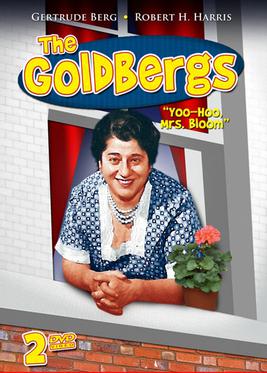
The Goldbergs is a comedy-drama broadcast from 1929 to 1946 on American radio, and from 1949 to 1956 on American television. It was adapted into a 1948 play, Me and Molly; a 1950 film The Goldbergs, and a 1973 Broadway musical, Molly. It also briefly spun off a comic strip from June 8, 1944, to December 21, 1945, with art by Irwin Hasen, a comic book artist who worked on various DC comics titles and would later do the Dondi comic strip.

Howdy Doody is an American children's television program that was created and produced by Victor F. Campbell and E. Roger Muir. It was broadcast on the NBC television network in the United States from December 27, 1947, until September 24, 1960. It was a pioneer of children's programming and set the pattern for many similar shows. One of the first television series produced at NBC in Rockefeller Center, in Studio 3A, it pioneered color production in 1956 and NBC used the show to promote color television sets in the late 1950s.

Hopalong Cassidy is a fictional cowboy hero created in 1904 by the author Clarence E. Mulford, who wrote a series of short stories and novels based on the character. Mulford portrayed the character as rude, dangerous, and rough-talking. He was shot in the leg during a gun fight which caused him to walk with a little "hop", hence the nickname.

George Francis "Gabby" Hayes was an American actor. He began as something of a leading man and a character player, but he was best known for his numerous appearances in B-Western film series as the bewhiskered, cantankerous, but ever-loyal and brave comic sidekick of the cowboy stars Hopalong Cassidy, Roy Rogers and John Wayne.
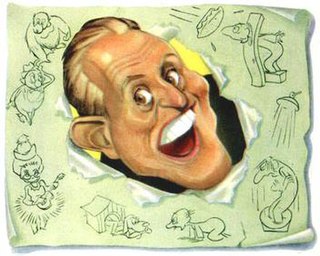
House Party is an American radio daytime variety/talk show that aired on CBS Radio and on ABC Radio from January 15, 1945 to October 13, 1967. The show had an equally long run on CBS Television as Art Linkletter's House Party and, in its final season, The Linkletter Show, airing from September 1, 1952 to September 5, 1969.
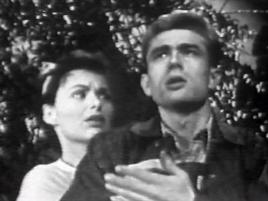
Robert Montgomery Presents is an American dramatic television series which was produced by NBC from January 30, 1950, until June 24, 1957. The live show had several sponsors during its eight-year run, and the title was altered to feature the sponsor, usually Lucky Strike cigarettes, for example, Robert Montgomery Presents Your Lucky Strike Theater, ....The Johnson's Wax Program, and so on.
Albert Horton Foote Jr. was an American playwright and screenwriter. He received Academy Awards for his screenplays for the 1962 film To Kill a Mockingbird, which was adapted from the 1960 novel of the same name by Harper Lee, and his original screenplay for the film Tender Mercies (1983). He was also known for his notable live television dramas produced during the Golden Age of Television.

Marvin Elliott Miller was an American actor. Possessing a deep baritone voice, he began his career in radio in St. Louis, Missouri before becoming a Hollywood actor. He is remembered for voicing Robby the Robot in the science fiction film Forbidden Planet (1956), a role he reprised in the lesser-known The Invisible Boy (1957).

Lux Video Theatre is an American television anthology series that was produced from 1950 until 1957. The series presented both comedy and drama in original teleplays, as well as abridged adaptations of films and plays.

John Herrick McIntire was an American character actor who appeared in 65 theatrical films and many television series. McIntire is well known for having replaced Ward Bond, upon Bond's sudden death in November 1960, as the star of NBC's Wagon Train. He played Christopher Hale, the leader of the wagon train from early 1961 to the series' end in 1965. He also replaced Charles Bickford, upon Bickford's death in 1967, as ranch owner Clay Grainger on NBC's The Virginian for four seasons.
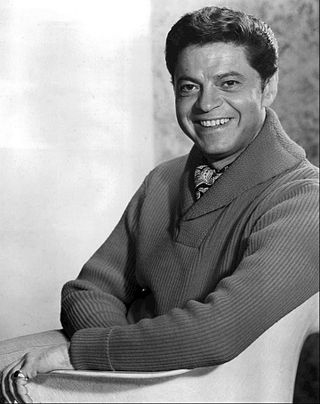
Ross Martin was an American radio, voice, stage, film, and television actor. Martin was best known for portraying Artemus Gordon on the CBS Western series The Wild Wild West, which aired from 1965 to 1969. He was the voice of Doctor Paul Williams in 1972's Sealab 2020, additional characters in 1973's Butch Cassidy and the Sundance Kids, and additional character voices in 1978's Jana of the Jungle.

Boris Karloff (1887-1969) was an English actor. He became known for his role as Frankenstein's monster in the 1931 Frankenstein, leading to a long career in film, radio, and television.
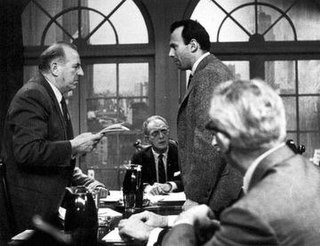
Kraft Television Theatre is an American anthology drama television series running from 1947 to 1958. It began May 7, 1947 on NBC, airing at 7:30pm on Wednesday evenings until December of that year. It first promoted MacLaren's Imperial Cheese, which was advertised nowhere else. In January 1948, it moved to 9pm on Wednesdays, continuing in that timeslot until 1958. Initially produced by the J. Walter Thompson advertising agency, the live hour-long series offered television plays with new stories and new characters each week, in addition to adaptations of such classics as A Christmas Carol and Alice in Wonderland. The program was broadcast live from Studio 8-H at 30 Rockefeller Plaza, currently the home of Saturday Night Live.
Winner Take All is an American radio-television game show that ran from 1946 to 1952 on CBS and NBC. It was the first game show produced by the Mark Goodson-Bill Todman partnership. The series was originally hosted by Ward Wilson, but is best known for being the first game hosted by Bill Cullen.

The Garry Moore Show is the name for several separate American variety series on the CBS television network in the 1950s and 1960s. Hosted by experienced radio performer Garry Moore, the series helped launch the careers of many comedic talents, such as Dorothy Loudon, Don Adams, George Gobel, Carol Burnett, Don Knotts, Lee Goodman, James Kirkwood, Jr., Lily Tomlin, and Jonathan Winters. The Garry Moore Show garnered a number of Emmy nominations and wins.
The Philco Television Playhouse is an American television anthology series that was broadcast live on NBC from 1948 to 1955. Produced by Fred Coe, the series was sponsored by Philco. It was one of the most respected dramatic shows of the Golden Age of Television, winning a 1954 Peabody Award and receiving eight Emmy nominations between 1951 and 1956.
Ford Theatre, spelled Ford Theater for the original radio version and known, in full, as The Ford Television Theatre for the TV version, is a radio and television anthology series broadcast in the United States in the 1940s and 1950s. At various times the television series appeared on all three major television networks, while the radio version was broadcast on two separate networks and on two separate coasts. Ford Theatre was named for its sponsor, the Ford Motor Company, which had an earlier success with its concert music series, The Ford Sunday Evening Hour (1934–42).

Martin Ellyot Manulis was an American television, film, and theatre producer. Manulis was best known for his work in the 1950s producing the CBS Television programs Suspense, Studio One Summer Theatre, Climax!, The Best of Broadway and Playhouse 90. He was the sole producer of the award-winning drama series, Playhouse 90, during its first two seasons from 1956 to 1958.
Break the Bank is an American quiz show which aired variously – and sometimes co-existed in separate radio and television forms – on Mutual Radio, ABC Radio and NBC Radio Network, as well ABC, CBS and NBC television, from 1945 to 1957. From October 1956 to January 1957, NBC aired a short-lived prime-time television version called Break the $250,000 Bank.
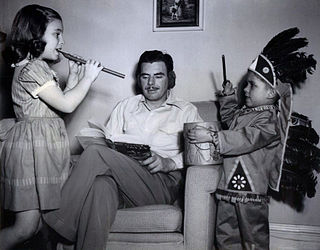
Nelson Olmsted was an actor in films and recordings, and on radio and television, from the 1950s to the 1970s. Sometimes billed as Nelson Olmstead, he was best known for an unusual NBC radio series, Sleep No More (1956–57), in which he narrated his own adaptations of terror tales and science-fantasy stories.















